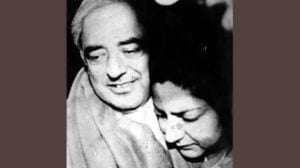Explained: What Supreme Court ruled in AMU minority status case
The top court has laid down a ‘holistic and realistic’ test to determine the ‘minority character’ of an educational institution that would ensure special protections under Article 30.
 Students at AMU’s main gate on Friday morning. (Abhinav Saha)
Students at AMU’s main gate on Friday morning. (Abhinav Saha)Is Aligarh Muslim University (AMU) a minority educational institution (MEI) with significant constitutional protections to manage its affairs?
A seven-judge Bench of the Supreme Court on Friday laid down in a 4-3 majority verdict a “holistic and realistic” test to determine the “minority character” of an educational institution, but left the factual determination on AMU to a smaller Bench.
However, the ruling essentially cleared the decks for AMU to secure its minority institution status.
Background of case
In 1967, the Supreme Court in S. Azeez Basha v Union of India held that AMU was neither established nor administered by the Muslim minority — it came into existence through an Act of the central legislature — and did not, therefore, qualify as a minority institution under Article 30 of the Constitution.
In 1981, the government amended the AMU Act, 1920, to say that the institution was established by the Muslim community to promote the cultural and educational advancement of Muslims in India.
In 2005, AMU provided 50% reservation for Muslims in postgraduate medical programs. In 2006, the Allahabad HC struck down both the university order and the 1981 amendment on the ground that AMU was not a minority institution as per Azeez Basha.
This judgment was challenged at the SC, and in 2019 the matter was referred to a seven-judge Bench.
Protections for MEIs
Under Article 30(1), all minorities have the right to establish and administer educational institutions of their choice. Under Article 15(5), MEIs are exempt from providing reservations for SCs and STs.
Minority status also allows educational institutions to exercise greater control over their day-to-day administration — from student admissions (they can reserve up to 50% seats for minority students) to the hiring of teaching and non-teaching staff.
Minority character
The majority decision, authored by Chief Justice of India D Y Chandrachud for himself and Justices Sanjiv Khanna, J B Pardiwala, and Manoj Misra, listed “core essentials” of minority character under Article 30(1).
- While the purpose of establishing a minority institution should be the conservation of language and culture, it need not be the only purpose;
- A minority institution will not lose its minority character by admitting students belonging to non-minorities;
- Secular education can be imparted at a minority institution without affecting its minority character;
- If a minority institution has received aid from the government, no student can be forced to participate in religious instruction; if the institution is fully maintained out of state funds, it cannot provide religious instruction. However these institutions must still be considered minority institutions.
Test laid down by SC
To determine if an institution actually has a minority character, the court held that it would have to “pierce the veil” and look into how it was established. To do this, it laid down certain criteria or “indicia” that must be considered as a part of a two-fold test.
ESTABLISHMENT: The first aspect of the test deals with the genesis or origin of the minority institution, the purpose of its establishment, and how the “idea” for the institution was finally implemented.
Courts must “trace the origin of the idea for the establishment of the institution” to determine who was the “brain behind the establishment”. For proof, a variety of sources could be considered — letters, correspondence with other community members or government officials, etc. The link must “point towards one member of the minority or a group from the community”, the court said.
The purpose of establishing the institution must “predominantly” be for the benefit of the minority community, even if it is not the sole purpose. Here too, the court suggested looking at correspondence or even speeches from the time about the “necessity” of establishing the institution, and recognition of the “educational difficulties” faced by the communities in question.
The next step was the implementation of the “idea”, the court said. Who contributed the funds for the institution? How was the land obtained or donated? Who obtained the necessary permissions, and handled the construction and infrastructure?
The AMU Old Boys’ Alumni Association, in written submissions, said that AMU was established after Sir Syed Ahmad Khan “found the Muslim community to be neglected and backward”. In the 1870s, the Muhammadan Anglo-Oriental (MAO) College Foundation Committee started collecting funds, and the MAO College was established. After the Muslim University Association was established in 1911, “long negotiations” with the government culminated in the Aligarh Muslim University Act, 1920, the Alumni Association submitted.
The Centre, however, argued that a “principal” aim behind the creation of MAO was the “promotion of Western Arts and Sciences and not just religious study”. On the implementation, it argued that “persons from all walks of life” contributed to establishing MAO. And even when the idea of a university in Aligarh was floated in 1911, the imperial government was clear that they would retain control, the Centre argued.
ADMINISTRATION: The court held that the administration of an educational institution does not need to be handled by the minority community; it was a matter of “choice” for such an institution, and it is not “compelled” to appoint persons from the minority community for day-to-day administration.
That said, the majority held that courts can look at the administrative set-up to see if it “affirms” the minority character of an institution. If the administration does not seem to “protect and promote the interests of the minority”, it could be “reasonably inferred that the purpose was not to establish an educational institution for the benefit of the minority community”.
For institutions that were established before the Constitution came into force (like AMU), the majority held that courts must look at how the administration worked “on the date of the commencement of the Constitution” (January 26, 1950) — and whether any “regulatory measures” were used to “wrest” control from the founders.
The petitioners argued that the ultimate power over the administration was with the Muslim community until 1950, with the ‘Court’ (AMU’s supreme governing body) entirely composed of Muslims.
However, the Centre argued that Sections 13 and 14 of the AMU Act gave “overriding authority” to the authorities, such that “the extent of government control over the AMU was far greater than over the MAO College”.
It also submitted that the AMU Act was amended in 1951 to do away with compulsory religious education and all-Muslim representation on the Court of the University in order to “…bring Aligarh Muslim University Act, 1920 in conformity with the constitutional provisions”.




- 01
- 02
- 03
- 04
- 05


































